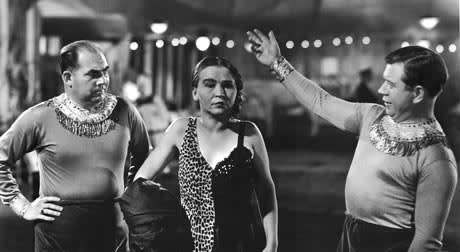Intended as a horror film, decried as exploitation and revived as cult cinema, Tod Browning's controversial 1932 film Freaks has without changing a frame of celluloid experienced more historical revisionism and fresh interpretation than perhaps any other movie in history. When it was made in pre-Code Hollywood, the studio sought to capitalise on the boom of "horror" films and turned to Browning, who had just guided Bela Legosi through the role of his career in Dracula. Browning was otherwise best known for a gangster flick called The Unholy Three, in which Freaks star Harry Earles plays the now-familiar cigar-smoking midget posing as a baby. Freaks afforded Browning the opportunity to indulge some of his more eccentric tendencies but also his past his teenage years were spent with circuses and sideshows before becoming a film director. So for Freaks, he scoured the world's best sideshow attractions to find his cast of little people, armless ladies, microcephalics (called "pinheads" in the film) and other physically unusual performers. But the film's story doesn't call for exploitation instead, it tells of a little person (played by Earles) who falls in love with a big woman who, he doesn't realise, is mocking him behind his back. The community of "freaks" eventually turns on the "normal" woman and ensures that she will experience life in their midst forever. ("One of us!") Upon its initial release, Freaks was misunderstood audiences were unwilling to see "half boy" Johnny Eck (who was discovered at the Canadian Exhibition) as anything but an 18-inch torso with a head. The film was banned shortly after its release, only to be rediscovered by a more Freaks-positive audience in the counter-cultural 1960s. Looking back at this remarkable DVD reissue, it's not a stretch to see Freaks as merely a soap opera set at a sideshow not more horrible, nor more unusual, nor more frightening than HBO's Carnivale or even Six Feet Under. Only the unusual circumstances make it notable. But such revisionism can also be used to gloss over the context and the intent of the film, and the experiences of its performers. As chronicled in a remarkable documentary (which updates the lives of each of the sideshow performers, no matter how small their role), making Freaks was not good times. These entertainment professionals did feel exploited and hated not only the experience but the final product as well. Yet impressions of the film continue to evolve with time, raising issues of political correctness, censorship, artistic vision and the nature of exploitation. Freaks is a fascinating document that remains so more than 65 years after it was made. Plus: commentary by scholar David L. Skal, three alternate endings. (Warner)
Freaks
Tod Browning

BY James KeastPublished Sep 1, 2004